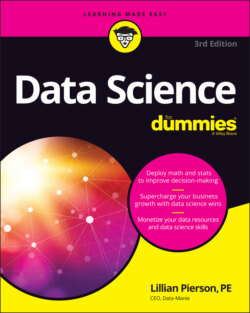Читать книгу Data Science For Dummies - Lillian Pierson - Страница 75
Turning to traditional MCDM
ОглавлениеYou can use MCDM methods in anything from stock portfolio management to fashion-trend evaluation, from disease outbreak control to land development decision-making. Anywhere you have two or more criteria on which you need to base your decision, you can use MCDM methods to help you evaluate alternatives.
To use multiple criteria decision-making, the following two assumptions must be satisfied:
Multiple criteria evaluation: You must have more than one criterion to optimize.
Zero-sum system: Optimizing with respect to one criterion must come at the sacrifice of at least one other criterion. This means that there must be trade-offs between criteria — to gain with respect to one means losing with respect to at least one other.
Another important thing to note about MCDM is that it’s characterized by binary membership. In mathematics, a set is a group of numbers that share a similar characteristic. In traditional set theory, membership is binary — in other words, an individual is either a member of a set or it’s not. If the individual is a member, it’s represented by the number 1, representing a “yes.” If it is not a member, it’s represented by the number 0, for “no.”
The best way to gain a solid grasp on MCDM is to see how it’s used to solve a real-world problem. MCDM is commonly used in investment portfolio theory. Pricing of individual financial instruments typically reflects the level of risk you incur, but an entire portfolio can be a mixture of virtually riskless investments (US government bonds, for example) and minimum-, moderate-, and high-risk investments. Your level of risk aversion dictates the general character of your investment portfolio. Highly risk-averse investors seek safer and less lucrative investments, and less risk-averse investors choose riskier, more lucrative investments. In the process of evaluating the risk of a potential investment, you’d likely consider the following criteria:
Earnings growth potential: Using a binary variable to score the earnings growth potential, then you could say that an investment that falls under a specific earnings growth potential threshold gets scored as 0 (as in “no — the potential is not enough”); anything higher than that threshold gets a 1 (for “yes — the potential is adequate”).
Earnings quality rating: Using a binary variable to score earnings quality ratings, then you could say that an investment falling within a particular ratings class for earnings quality gets scored as 1 (for “yes — the rating is adequate”); otherwise, it gets scored as a 0 (as in “no — it’s earning quality rating is not good enough”).For you non-Wall Street types out there, earnings quality refers to various measures used to determine how kosher a company’s reported earnings are; such measures attempt to answer the question, “Do these reported figures pass the smell test?”
Dividend performance: Using a binary variable to score dividend performance, then you could say that when an investment fails to reach a set dividend performance threshold, it gets a 0 (as in “no — it’s dividend performance is not good enough”); if it reaches or surpasses that threshold, it gets a 1 (for “yes — the performance is adequate”).
Imagine that you’re evaluating 20 different potential investments. In this evaluation, you’d score each criterion for each of the investments. To eliminate poor investment choices, simply sum the criteria scores for each of the alternatives and then dismiss any investments that don’t earn a total score of 3 — leaving you with the investments that fall within a certain threshold of earning growth potential, that have good earnings quality, and whose dividends perform at a level that’s acceptable to you.
For some hands-on practice doing multiple criteria decision-making, go to the companion website to this book (www.businessgrowth.ai) and check out the MCDM practice problem I’ve left for you there.
